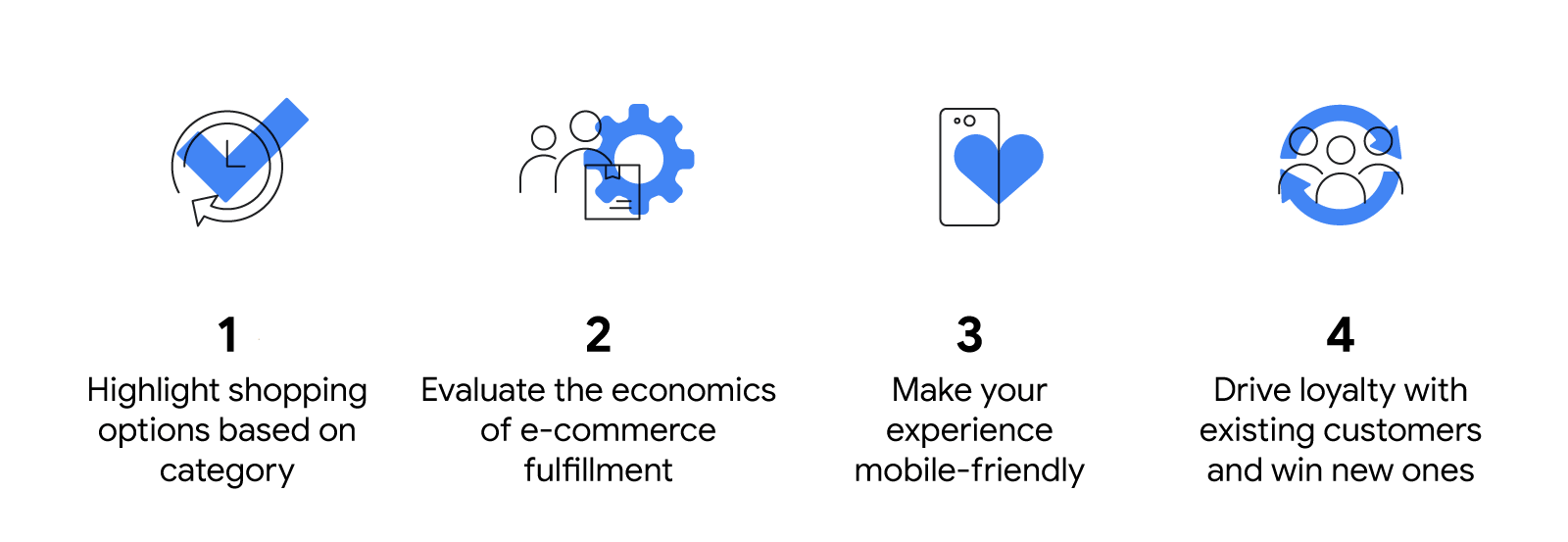Google and Boston Consulting Group conducted a series of surveys to understand changes in consumer shopping behavior ahead of the holiday shopping season. Suchi Sastri, managing director and partner at Boston Consulting Group, breaks down what the findings mean for retailers.
I work closely with retailers across the globe on their large-scale digital transformations as a partner at Boston Consulting Group. As the holiday season approaches and the pandemic continues to evolve, many of my clients want to know what to expect. Will e-commerce continue to grow at the rate it did last year? How big of a role will in-store shopping play in holiday shopping? While it’s still early, fewer U.S. holiday shoppers say that COVID-19 will impact how they shop for the holidays this year — only 35% compared with 53% in 2020.1 At the same time, consumers have permanently changed how, when, and where they shop.
To better help retailers understand these changes, we launched a series of surveys in partnership with Google and Dynata to over 12,000 U.S. consumers across retail categories. Here’s what we found.
From our partners:
This season’s shopper will be more omnichannel than ever
During the pandemic, we saw a dramatic shift toward e-commerce. As we looked closer, we saw that while the move online happened quickly, e-commerce has stabilized as people look for more in-person experiences.2 In fact, only 14% of U.S. shoppers say they will not shop in-store this holiday season.3 But as in-store shopping resurges, digital’s role in shopping has been cemented, as more than 70% of surveyed participants reported that their shopping journey involved online touchpoints.4 Digital will be a critical part of their journey, whether it’s online or in-store.
Digital’s role in shopping has been cemented, as more than 70% of surveyed participants reported that their shopping journey involved online touchpoints.
How you can meet the moment with your marketing this holiday
So what does this mean for your business, and how should you adapt your holiday marketing strategy? Taking a closer look at category-level insights, here are a few tips that BCG recommends retailers — whether you have stores or not — consider this holiday season.

1. Highlight shopping options based on category
To consumers, the role of the store will vary based on their needs and the category of products offered. We found four primary motivations that bring consumers in-store — convenience, immediacy, in-person experience, and product trial. We also found that product categories tended to align with these pairs of motivations.
- Convenience or immediacy motivates approximately 40% of people shopping in-store for grocery, beauty and toiletries, pet care, health care, small appliances, home improvement, and auto parts.5 We see this on Google, where searches for “now near me” have grown globally by over 100% year over year.6
Experience or product trial motivates consumers to shop in-store for jewelry, handbags, and accessories, apparel and footwear, home furniture, mattresses, and major appliances. For example, searches for “furniture shop near me” have grown globally by over 100% year over year.
READ MORE: The Top 10 Affordable Products That’ll Help Make Your Life A Little Easier
For retailers that fall into multiple categories, the pairings of experience and product trial for in-store shopping might point to highlighting options based on category. For instance, you should promote your curbside options for convenience categories like grocery and pet. Or consider showcasing your digitally enabled experiences like virtual try-on to emphasize product-trial experience for categories such as beauty or home goods.
2. Evaluate the economics of e-commerce fulfillment
Our research found that consumer fulfillment needs differ, depending on what spurs a product purchase. Matching urgency of need to delivery speed can help mitigate the economic pressure of providing fast delivery everywhere for everything. For example, when urgency is low for products such as personal indulgences (think: sneakers) or upcoming special occasions, many retailers still deliver packages sooner than consumers need them. By contrast, when consumers shop for products such as major appliances, over a quarter of shoppers report that they aren’t getting them fast enough.8 Understanding your customers’ delivery needs and marketing against them are both essential for optimizing their experience and optimizing for your margins.
3. Make your experience mobile-friendly
The shopper continues to be mobile first, which has become even more pronounced in the past year. Since the pandemic’s onset, more than a quarter of online shoppers are shopping on their mobile devices — ranging as high as 44% for grocery — though many have had nearly constant access to their home computers.9 This includes app usage and downloads, which we’ve seen reflected on Google, where searches for “online shopping app download” have grown globally by over 300% year over year.10 Retailers need to recognize the distinctive aspects of each channel and optimize the experience accordingly. Consider deep-linking or driving app downloads for categories like grocery that are mobile heavy.
4. Drive loyalty with existing customers and win new ones
Because this year’s shopper is likely to be more omnichannel than ever, digital channels will continue to be a critical touchpoint in the consumer shopping journey for both acquiring new customers and driving loyalty with existing customers. According to our research, 64% of existing customers, on average, engaged with a digital touchpoint during their shopping journey,11 while 80% of new customers, on average, engaged with a digital touchpoint during their shopping journey.12 As always, when demand is unpredictable, automated solutions help you get in front of the right customers at the right time.
To learn more about insights like these, and how to prepare your business and marketing strategy for this holiday season, watch Think Retail on Air, now available on demand.
Source: Think with Google
For enquiries, product placements, sponsorships, and collaborations, connect with us at hello@zedista.com. We'd love to hear from you!
Our humans need coffee too! Your support is highly appreciated, thank you!

